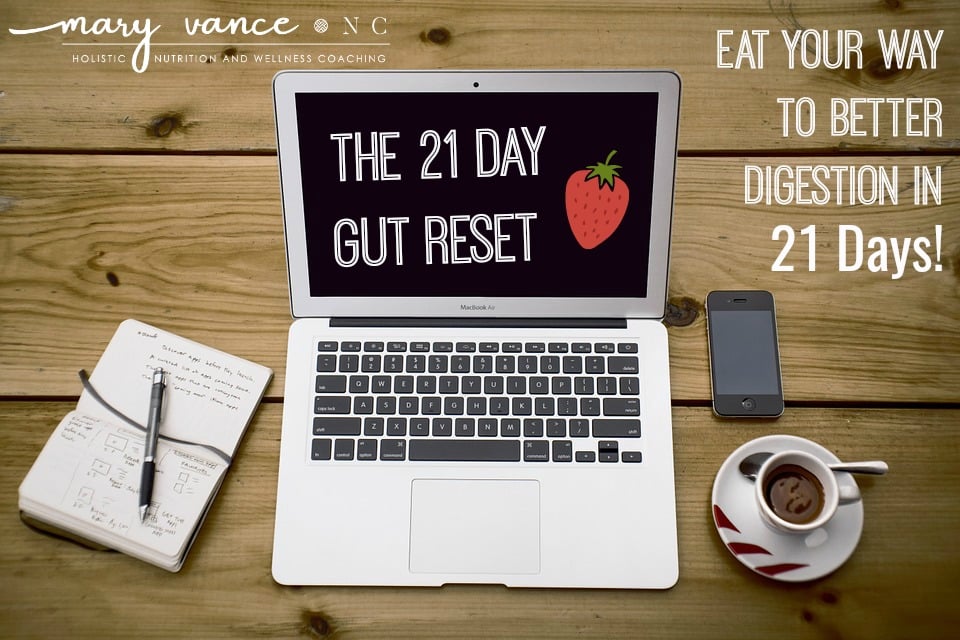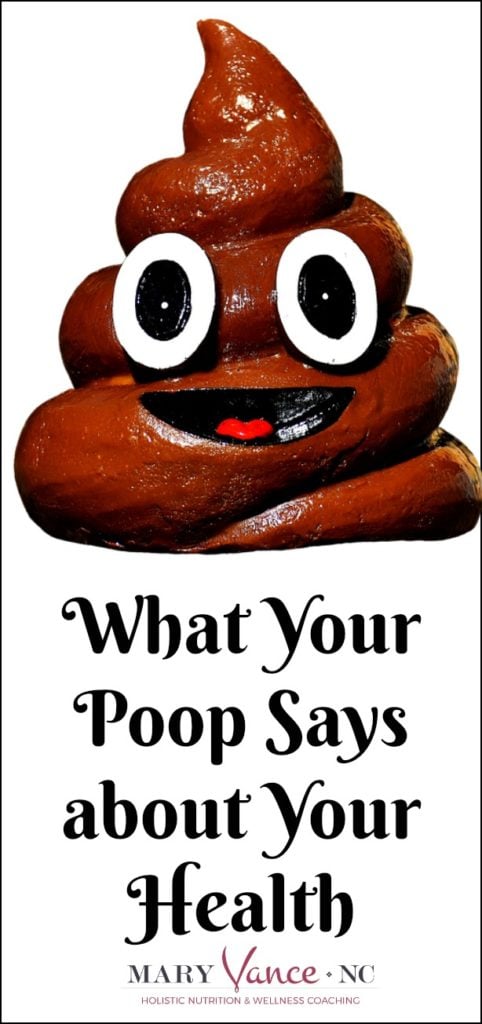Let’s talk about poop, baby.
Poo has become a super taboo topic, and I’m not going to sugarcoat it and make it cutesy (other than the word poo because it’s short and to the point). Let’s just have a straightforward discussion about what your poop says about your health and why you should turn around and look after you make a deposit.
60 to 70 million people in the United States are affected by digestive diseases, including chronic constipation, IBS, IBD, diverticular disease, GERD, and hemorrhoids, to name the main afflictions. (source)
10 to 15 percent of people struggle with IBS (inflammatory bowel syndrome), and there are between 2.4 and 3.5 million annual physician visits for IBS in the United States alone. (source) About 1.3 million people suffer from IBD (inflammatory bowel disease), either Crohn’s or ulcerative colitis.
That’s a lot of people struggling with digestive issues and pooping problems.
With all the access we have to modern tests and assessments, there’s really no easier way to see what’s going on inside your body than to turn around and look at what’s coming out of it. Your poop can reveal signs of infections, digestive problems, and even early signs of cancer (source),
What is Poop?
The ideal poop is made of about 75 percent water and 25 percent waste, fiber, dead cells, and dead bacteria.
Short physiology lesson: When you eat, food is broken down in the mouth and stomach before entering the small intestine. There, protein, fats, and usable carbs are broken down further, and the nutrients are absorbed through the wall of your small intestine and into your bloodstream. What remains moves on to the large intestine (thanks to peristalsis) where your gut bacteria go to work on the leftover fibers and starches that you can’t digest. The final waste continues its journey down into your colon and out into the toilet, ideally 18-24 hours after you ate.
How Often Should I Poop?
I ask every single client with whom I work how often they poop, what it looks like, and a number of other potentially embarrassing (for them) questions about their pooping experiences and symptoms. I’m always surprised and saddened to hear that most are not pooping daily. While it may not be your normal to poop every single day, if you’re regularly going 2 days or more without a bowel movement, you are constipated. Even worse, I’ve had clients tell me their primary care doctor says it’s ok to only poop once per week. No, that is not ok.
When you go too long between poops, waste is sitting in your colon. Toxins, cholesterol, and hormones (yes, your fecal waste binds up excess hormones for excretion) can be reabsorbed through the colon wall and back into your system where you don’t want it– after all, it was meant for removal. That can contribute to estrogen dominance and high cholesterol and make you feel sluggish, bloated, and tired.
So the answer is: Ideally, you want to poop once or twice a day. And not just a bunch of little pebbles or squirts; you want a nice, small banana-sized, log-like specimen.
While frequency depends on a number of factors, it’s normal to skip a day; it’s normal to go more than once a day; but if you’re regularly feeling stopped up or only going every couple of days, you are constipated. Constipation is technically defined as pooping fewer than three times per week and/or difficulty pooping, incomplete evacuation, hardened stool.
On the other hand, if you’re consistently pooping more than three times a day or experiencing loose, watery stool and pooping too frequently, you have chronic diarrhea.
What Your Poop Says about Your Health
The perfect poo is a well formed continuous log, not too dark, not too light, is produced easily, painlessly, and without straining, and sinks slowly to the bottom of the toilet. Really, there isn’t much better in life than the perfect poop, am I right?
It’s important is to establish what is normal for you, and if there is a prolonged change, determine the cause. The idea poop should be free from food particles, frequent and noticeable mucous, or blood. Generally a brown or deep chocolatey color is good; green is normal occasionally also (usually means you ate a lot of greens or could be from vitamins). Consistently dark or black stool could signal internal bleeding.
Here’s a handy chart to explain visually what your poop should look like. You want to aim for a 3 or a 4.
1 and 2 generally mean you’re constipated or not drinking enough water. Even if you’re going every day, if you’re only ejecting a few hard pebbles or a small, hard poop, that is still considered constipation. 5-7 isn’t good because it may mean your food is moving through your system too quickly, and you’re not absorbing nutrients from your food. It could also signal IBS or that you’re not getting enough fiber.
Your poo should smell vaguely sweet but not entirely pleasant. I mean, it’s not going to smell like roses, but it shouldn’t be foul or noxious on an ongoing basis. Certain foods like eggs and cruciferous veggies can make your poop smell sulfurous, but if your stool is a regular intolerable stink bomb, it could indicate bowel disease, infections, indigestion issues, or a poor diet.
Long as we’re on the topic of the stank, it’s normal to pass gas 10-18 times daily. More than that indicates bacteria imbalance, food intolerance, eating too fast, or indigestion issues. Start with a digestive enzyme and a probiotic, or consider a GI tuneup if you’re a fart factory.
Troubleshooting Your Poop
Remember that you want to determine what is normal for you. Most of us will have inconsistent poops from time to time, but as long as you don’t stray from your normal for too long, it’s probably fine.
Floaters: we established that you want your poop to sink. That means you’re getting enough fiber. The occasional floater is no big thang, but if your poop floats consistently, it means you’re not getting enough fiber, that’s there’s excess gas, or that you have malabsorption issues. Floaters may also signify celiac or pancreatic issues.
Greasy: if you notice a grease slick in the toilet (often accompanies floaters), it probably means you’re not properly absorbing fats from your diet. You might be getting too much fat, or you’re not producing enough lipase or pancreatic enzymes to properly break down and absorb fats. Try a digestive enzyme and eat more plants and easy-to-digest fats like coconut oil.
Mucous: stool contains some mucous by nature, but if you consistently see what looks like pus or mucous in your stool, it may indicate inflammation or be associated with Crohn’s, IBS, colitis, infections, candida, or malabsorption issues.
Pencil thin: while we all might have thin poops occasionally, chronic pencil thin may indicate rectal cancer, which narrows the opening through which stool passes.
Blood: if it’s bright red, it usually means fissures or hemorrhoids. No big deal if it happens once in a blue moon. Dark red blood or black stool may indicate bleeding farther up the GI tract, and it’s a pretty big concern. The stool test I use detects occult blood that may not be visible (get it here, 7th down on the test menu). Regardless, if you notice either recurring, see a doctor. Be aware also that eating beets turns your poop red. More of a maroon, really.
Gray: occurs when the liver does not release enough bile salts into the stool. This may occur due to bile duct blockages, gallstones or liver problems. Pretty serious if it continues.
Food: seeing undigested food in your stool means you’re not breaking down food effectively. Try chewing more slowly and take a digestive enzyme. If it persists, you need a digestive tuneup.
Constipation: read my post all about troubleshooting constipation. It has many causes, including poor diet, dehydration, hypothyroidism, IBS, SIBO or other gut imbalances.
Diarrhea: an infrequent bout is bound to happen and is a good sign if your body is quickly trying to expel a pathogen. But if it happens regularly, it could signal IBD, IBS, SIBO, food intolerance, hyperthyroid, celiac, parasite, or other GI infection.
Irregularity: if you fluctuate between constipation and diarrhea, for example, it could signal candida or dysbiosis. Consider a candida cleanse or GI tuneup.
How to Better Your BMs
Want a better poo? Follow these tips:
- Drink at least 10 cups or water or half your body weight in ounces daily. Dehydration will get you a 1 or a 2 on the Bristol stool chart.
- Dump the junk: no white bread, pasta, junk food, processed foods. Strive to stay away from anything artificial or highly refined. That means eat food as close to its natural state as possible.
- What really makes a good stool is large amounts of the indigestible plant matter that feed your gut bacteria (remember, this is the leftover stuff that moves through your small intestine because you can’t digest it, but it’s food for the bacteria in your large intestine). This plant fiber also adds bulk to poop, so a plant-heavy diet is critical for nice, solid poos. Aim for 40 grams of fiber daily at least. 40 grams (some practitioners recommend 50) is a heck of a lot of plants, fruit, legumes (a cup of lentils has like 17 grams of fiber!!), nuts, seeds. Basically complex carbs. Aim to get 2 cereal bowls’ worth of vegetables of all types daily. Beans and lentils are excellent fiber sources also. Wheat and most grains are usually not, and many people with GI issues don’t digest grains well. Stick to quinoa and wild rice, which are very high in fiber, if you do grains. NOTE that if you have SIBO, increasing fiber will potentially worsen constipation or gut pain, and you may need to reduce fiber while you’re healing.
- Boost your gut flora by eating and drinking fermented things like raw kraut, water kefir, and naturally fermented pickles (NOT the bright green ones in the jars. They’re pasteurized, which kills the beneficial bacteria). You want to introduce probiotics to boost probiotic diversity as well as provide fibers and starches (prebiotics) to feed your probiotics. There’s a whole ecosystem in there that needs to be fed.
- Exercise! It’s good for regularity. Get some movement daily. A 15 minute walk would suffice.
- Certain meds affect BMs. Ask your doctor.
How to Poop Properly
Want to achieve the perfect poop? You’ve come to the right place. Pooping well is so important to me that my friends make fun of me because I have a very specific morning routine to produce the perfect poo.
First off, poop at the same time every day. First thing in the AM is good. Train yourself to get on a schedule. Really, it works.
So, the perfect poop starts the day before. Drink enough water. Get enough fiber (example: a fiber-packed morning smoothie, a lentil salad with arugula at lunch, an apple with almond butter, and meat and roasted veggies with avocado and raw kraut will usually do the trick). Get your fermented foods daily. Bonus: they help you digest meals because they contain enzymes.
If you struggle with constipation, try magnesium the night before at bedtime. This one is great for constipation, and this one supports regularity.
When you get up, try hot water with lemon or green tea to get things moving. A warm beverage often does the trick. Invest in a squatty potty to help you poop with ease. It “uncoils” your colon for a more healthy poo. Did you know that sitting on a toilet really isn’t conducive to the easiest poo?
Try this for several days to get into a routine. If it’s not working out for you, try triphala to help tone your bowel. Take a probiotic and a digestive enzyme. Consider a gut tuneup.
If things still aren’t going your way poop-wise, it might be time for some help. I recommend all my clients with digestive concerns do a stool test (the GI MAP) so we can get a picture of everything going on in the gut. Parasites, inflammation, pathogenic bacteria (like h pylori), yeast, or SIBO can cause chronic pooping woes. Hypothyroid causes chronic constipation. Guidance about how to change your diet helps, too. Read more on how to feed your microbiome.
Want Even More Support? The 21 Day Gut Reset is for YOU!
Please consider joining my 21 day gut reset program. You can join at any time, as it’s a self-paced e-course. All you need is a little motivation and an email address to join! Check out everything you’ll get:
- get rid of bloating, constipation, heartburn, gas, and indigestion
- have more energy, better focus, a flatter belly, glowing skin!
- receive a daily email for 21 days to help you heal your gut
- includes a 21 day meal plan: gluten, dairy, soy, refined sugar free
- 80+ easy & delicious gut healing recipes
- shopping list
- access to our private support group where you can ask questions and get even more info!
- a chart to help you build meals
- info on supplements you may need to enhance your journey
- Click here to join us!
Here’s to happy poops!
Pin it!

Mary Vance is a Certified Nutrition Consultant and author specializing in digestive health. She combines a science-based approach with natural therapies to rebalance the body. In addition to her 1:1 coaching, she offers courses to help you heal your gut and improve your health. Mary lives in San Francisco and Lake Tahoe in Northern California. Read more about her coaching practice here and her background here.









Right on Mary… I love the way you shoot from the hip and just tell everything how it is. Why not I say… just say it. I really enjoyed reading your article but this one in particular is a really great read and everyone should read this article of yours to keep everything in perspective. Those readers out there should really give a “POOP” what goes in should come out and in good time. Stay healthy everyone.
Hi Mary, when I woke up today I didn’t think I was going to read about poo, let alone wanting to know a bit more!
What I never gave a second thought to was floaters and sinkers (if that’s even a term) and why they sink or float. It makes sense there would be a density threshold for poo to sink which would tell you there are pockets of gas in the stool.
What I’d like to know is whether the type of poo you have has a further impact on the health of your skin? Besides having diarrhea and being dehydrated of course!
Excellent question, Jessica. The first thing that comes to mind is constipation can contribute to acne for the reasons I mention in the post: toxins that are reabsorbed from stool in your colon and recirculated in your system contribute to your overall toxic load. And a buildup of toxins in the body or a congested liver means skin eruptions and acne. Lack of fiber in the diet could cause a similar issue– not enough fiber in the stool = not enough bulk = toxins and hormones (excess estrogens, which cause acne) aren’t being properly bound up and excreted. Hope this helps.
Glad you enjoyed the poop talk, Gene! 😀 In all seriousness, it’s a super important way to gauge health, and the health of your stool can let you know what you need more (or less) of in your diet.
Hi Mary, that does help. Interestingly it raises further questions about excess hormones ending up in water supplies further down the line if there are not adequate steps in water purification to break them down!
But I imagine the contraceptive pill is a larger contributor to that! Thanks for the fab info!
Hi MAry, I chanced upon your blog and this was an interesting read. I’m just wondering how come you recommended NOW enzyme instead of YL’s essentialzyme.
Hi Fran, I don’t recommend MLM companies out of personal preference. In terms of enzymes, there are many great options out there, but the ones I recommend always contain HCl, bile salts, and usually pepsin.
I was attracted to your blog because o f your interest on the perfect poop as it seems now with a consipation issue it’s become one of the main things in my life !
I also love the fact that you recomend triphala instead of one of the harsher prokenetic
I’m sure you would teach anyone the best way to poop!it was a great read…